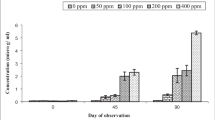Abstract
The incorporation and removal of strontium from the bones and teeth of rats under conditions of low and high dietary levels of strontium were investigated. In an otherwise satisfactory diet, an amount of strontium equimolar to that of calcium seriously debilitates the young growing rat and may culminate in death. The pathology due to strontium was found by the methods used only in the hard tissues. The excess osteoid formed originally in the presence of large amounts of dietary strontium is removed during a subsequent period of feeding on a low strontium regimen. Strontium removal from participation in physiologic processes appears to be of two types, (a) excretion from the body, and (b) incarceration within the hard tissues. The translocation of strontium to the incisor teeth has been demonstrated. Differences of sodium and potassium contents of the hemi-mandibulae of the experimental and control groups were also observed.
Résumé
L'on a procédé à une étude approfondie sur l'incorporation et l'enlèvement du strontium des os et des dents de rats dans les cas de régimes alimentaires à forte et faible teneur en strontium. Dans le cas d'un régime par ailleurs en tous points satisfaisant, l'adjonction d'une quantité de strontium de masse égale à celle du calcium provoque un phénomene débilitant très severe chez le jeune rat en pleine croissance, et peut même conduire à la mort du sujet. Les effets pathogéniques du strontium ont été découverts par des méthodes utilisées seulement en recherche dans les tissus durs. L'excédent de cellules osseuses, formées à l'origine du fait de la présence de grandes quantités de strontium dans l'alimentation, se résorbe si l'on passe à un regime à faible teneur en strontium. Il apparait qu'il y a deux types d'élimination dustrontium de l'organisme: a) par excrétion, et b) par assimilation dans les tissus durs. L'on n'a plus à démontrer que le strontium s'intègre par transfert dans les incisives. L'on a également observé, chez les sujets expérimentaux aussi bien que chez ceux du groupe de vérification, que des différences dans le taux de sodium et de potassium apparaissent dans les semi-mandibules.
Zusammenfassung
Die Einlagerung sowie die Resorption von Strontium wurde an Rattenknochen und-zähnen mittels Zugabe von niedrigen und hohen Strontiumdosen zu der Diät untersucht. Wird bei einer sonst befriedigenden Diät Calcium durch äquimolare Strontiummengen ersetzt, so entsteht eine Schwächung bei jungen wachsenden Ratten, die bis zum Tode führen kann. Die pathologischen, durch Strontium entstandenen Veränderungen wurden nur mit denjenigen Methoden verfolgt, die zur Untersuchung der harten Gewebe angewendet werden. Das Übermaß an osteoidem Gewebe, welches ursprünglich bei Zugabe großer Strontiummengen zu der Nahrung entsteht, wird in einer darauffolgenden strontiumarmen Diätperiode resorbiert. Die Resorption des Strontiums scheint an zwei physiologische Prozesse gebunden zu sein: a) Ausscheidung aus dem Organismus; b) Eingliederung in die harten Gewebe. Der Strontiumtransport in den Schneidezähnen ist bewiesen worden. Es wurden auch Unterschiede im Natrium- und Kaliumgehalt des halben Unterkiefers bei Experiment- und Kontrollgruppen beobachtet.
Similar content being viewed by others
References
Bauer, G. C. H.:85Strontium and47calcium in the study of bone. In: Radioisotopes and bone, p. 95, ed. under the direction ofF. A. MacLean withP. Lacroix andA. M. Budy. Philadelphia: F. A. Davis Co. 1962.
Clark, E. P., andJ. B. Collip: A study of the Tisdall method of the determination of blood serum calcium with a suggested modification. J. biol. Chem.63, 461–464 (1925).
Engstrom, A., R. Bjornestedt, C. J. Clemedson, andA. Nelson: Bone and radiostrontium, p. 21. New York: John Wiley & Sons, Inc. 1957.
Filonowich, L.: X-ray fluorescence of biological materials. Master's thesis. Minneapolis: University of Minnesota 1963.
Fiske, C. H., andY. Subba Row: Determination of phosphorus. J. biol. Chem.66, 375–400 (1925).
Goldenberg, H., andA. E. Sobel: Calcification IX. Influence of alkaline earths on survival of the calcifying mechanism. Proc. Soc. exp. Biol. Med. (N.Y.)81, 695–698 (1952).
Holgate, W., R. H. Mole, andJ. Vaughn: Accumulation of strontium-90 in dental tissues. Nature (Lond.)182, 1294–1295 (1958).
Johnson, A. R.: The relationship of calcium and strontium in the mineralized tissues of the rat: Replacement and exchange of these elementsIn vivo andIn vitro Ph. D. Thesis, p. 33, 35, 45, 51. Minneapolis: University of Minnesota 1966.
—, andL. Singer: Strontium incorporation into dental enamel. Science153, 1396–1397 (1966).
Kinney, E. M., andE. V. McCollum: A study of the rate of deposition and paths of absorption of strontium in the rat. J. Pharmacol. exp. Ther.21, 165–176 (1923).
MacDonald, N. S., R. E. Nusbaum, R. Stearns, F. Ezmirlian C. McArthur, andP. Spain: The skeletal deposition of non-radioactive strontium. J. biol. Chem.188, 137–143 (1951).
Neuman, W. F., andM. W. Neuman: The chemical dynamics of bone mineral, p. 99. Chicago: University of Chicago Press 1958.
Shorr, E., andA. C. Carter: The value of strontium as an adjuvant to calcium in the remineralization of the skeleton in osteoporosis in man. In: Metabolic Interrelations, Transactions of the Second Conf. p. 144–154. ed. byEdward C. Reifenstein, Jr., M. D.. New York: Josiah Macy,Jr. Foundation 1950.
Singer, L., W. D. Armstrong, andL. M. Colman: Microdetermination of calcium in biological materials. Analyt. Biochem.9, 217–223 (1964).
Sobel, A. E., J. Cohen, andB. Kramer: The nature of the injury to the calcifying mechanism in rickets due to strontium. Biochem. J.29, 2640–2645 (1935).
Author information
Authors and Affiliations
Additional information
This investigation was performed in partial fulfillment of the requirements for the degree of Doctor of Philosophy at the University of Minnesota (A.R.J.) and was supported by Grant DE 01850 of the National Institutes of Health.
Rights and permissions
About this article
Cite this article
Johnson, A.R., Armstrong, W.D. & Singer, L. The incorporation and removal of large amounts of strontium by physiologic mechanisms in mineralized tissues of the rat. Calc. Tis Res. 2, 242–252 (1968). https://doi.org/10.1007/BF02279212
Received:
Issue Date:
DOI: https://doi.org/10.1007/BF02279212




